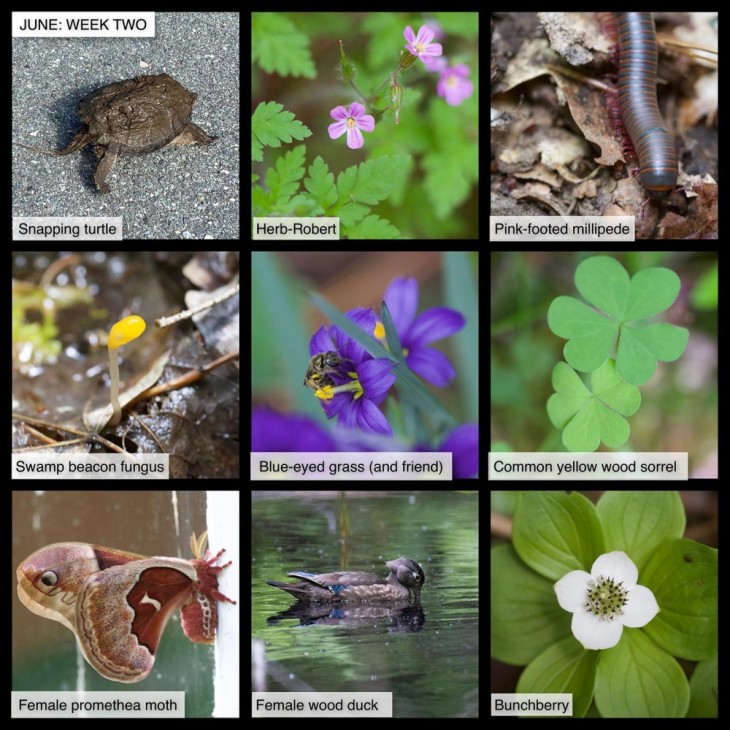This week, we’re straying out of the woods, and out of our “15 miles from the office” rule, to share a photo by Meghan McCarthy McPhaul of a snapping turtle crossing a road in Sugar Hill. Many turtles are crossing roads to reach nesting sites; please look out for them, and when you can, help them get across the pavement safely! Snapping turtles pose a special challenge to would-be-rescuers because of their long necks and powerful bites. Here’s an Outside Story article about the species by Brett Amy Thelen, and a profile from the Vermont Reptile & Amphibian Atlas, which includes a video showing how to move snapping turtles without harm to their spines, or your fingers.
Herb-Robert is in bloom. According to The Native Plant Trust, this tiny geranium may have been named after an acclaimed herbalist, or Robin Hood. It’s a member in good standing of the northern woods, but out West, it’s considered a noxious weed and sometimes goes by the epithet “Stinky Bob.”
We’ve noticed pink-footed millipedes moving along the forest floor. They’re peaceful recyclers of old leaves and other detritus, although they can be unnerving – they can grow four inches long and are remarkably fast. Here’s a link from earthlife.net about millipedes. Kids may also enjoy learning about the biggest millipede that ever lived, arthropleura, which was roughly the length of a car and skittered around during the Carboniferous Era. Here’s a link (go to minute 7:35) to Episode 2 of the BBC’s “Walking with Monsters” documentary, which features arthropleura and other Carboniferous era creatures. Warning: not for the squeamish.
The glowing fruiting bodies of swamp beacon fungus (also called matchstick fungus) are popping up now in shallow water and moist leaf litter. There are several species that go by this name, but they’re all related and look pretty much the same: yellow-to-orange heads on top of gangly stems. According to mycologist Lawrence Millman, in Fascinating Fungi of New England, they are probably associated with oak or maple leaves. Here’s a link with more information.
Tiny blue-eyed grass (here show with an even tinier bee) is in bloom in fields and woods edges. For most of us mortals, “blue-eyed grass” is sufficient, but it you’d like to botanize, there are several species. Here’s a roster with descriptions from The Native Plant Trust.
Common yellow wood sorrel is popping up in sunny woods and also fields. This kid favorite also goes by the name of “lemon clover.” Its leaves have a strong citrus flavor. Here’s a discussion of the plant from the Brooklyn Botanic Garden, including the fun fact that it takes a ballistic approach to spreading its seeds.
Giant silk moths (Saturniidae) are appearing now, including fuzzy bodied Promethea moths. The females are reddish; the males are sooty black. Silk moth numbers have dropped in part because of a biological control effort gone wrong – non-native parasitic tachinid flies, released to kill gypsy moth larvae, also prey on other, native moth species. Here’s an article describing New Hampshire artist Lucy Golden’s work to raise giant silk moths.
We haven’t spied any wood duck ducklings emerging from their nests in tree cavities or duck boxes yet, but adults are making frequent stops at vernal pools and ponds. Here’s a profile of the birds from Cornell, including an audio recording of their distinctive flight call (second sound file down), and here’s an article by Carolyn Lorié, describing female wood duck’s sneaky practice of “egg dumping” in other ducks’ nests.
Finally, while you’re out scouting for wood ducks, take a moment to look down at the water’s edge. You’re likely to find bunchberry in bloom right now. As the name indicates, this dogwood genus flower grows in bunches. Here’s a profile from Adirondacks Forever Wild.
In this difficult period, many of us find joy in observing local nature, and many families are seeking outdoor enrichment opportunities for children. Here are nine photographs taken this past week in forests within 15 miles of the Northern Woodlands office in Lyme, New Hampshire. We hope you enjoy using this grid as a prompt for your own explorations, or as the basis for a game of family forest tic-tac-toe.
What are you seeing in the woods this week? Share your images with us on Facebook, or submit a special photo for possible inclusion in our monthly online Reader Photo Gallery.



Discussion *